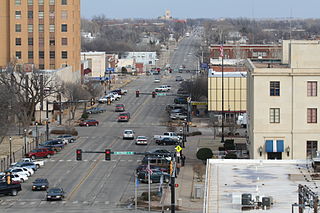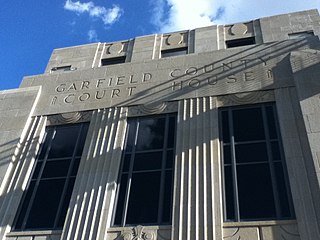
Garfield County is a county located in the U.S. state of Oklahoma. As of the 2010 census, the population was 60,580. Enid is the county seat and largest city within Garfield County. The county is named after President James A. Garfield.

The Interborough Rapid Transit Company (IRT) was the private operator of the original underground New York City Subway line that opened in 1904, as well as earlier elevated railways and additional rapid transit lines in New York City. The IRT was purchased by the city in June 1940. The former IRT lines are now the A Division or IRT Division of the Subway.

The Brooklyn Rapid Transit Company (BRT) was a public transit holding company formed in 1896 to acquire and consolidate railway lines in Brooklyn and Queens, New York City, United States. It was a prominent corporation and industry leader using the single-letter symbol B on the New York Stock Exchange. It operated both passenger and freight services on its rail rapid transit, elevated and subway network, making it unique among the 3 companies which built and operated subway lines in New York City. It became insolvent in 1919 and was restructured and released from bankruptcy as the Brooklyn–Manhattan Transit Corporation in 1923.
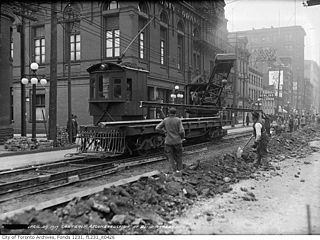
The Toronto Railway Company (TRC) was the operator of the streetcar system in Toronto between 1891 and 1921. It electrified the horsecar system it inherited from the previous operator.
Starting in 1899, the Brooklyn Rapid Transit Company and Brooklyn–Manhattan Transit Corporation operated rapid transit lines in New York City — at first only elevated railways and later also subways.

The Guelph Transit Commission is a small public transportation agency that operates transit bus services in Guelph, Ontario, Canada. Established in 1929 after the closure of the Guelph Radial Railway Company streetcar lines, Guelph Transit has grown to comprise over 70 buses serving 28 transit routes.

New York State Railways was a subsidiary of the New York Central Railroad that controlled several large city streetcar and electric interurban systems in upstate New York. It included the city transit lines in Rochester, Syracuse, Utica, Oneida and Rome, plus various interurban lines connecting those cities. New York State Railways also held a 50% interest in the Schenectady Railway Company, but it remained a separate independent operation. The New York Central took control of the Rochester Railway Company, the Rochester and Eastern Rapid Railway and the Rochester and Sodus Bay Railway in 1905, and the Mohawk Valley Company was formed by the railroad to manage these new acquisitions. New York State Railways was formed in 1909 when the properties controlled by the Mohawk Valley Company were merged. In 1912 it added the Rochester and Suburban Railway, the Syracuse Rapid Transit Railway, the Oneida Railway, and the Utica and Mohawk Valley Railway. The New York Central Railroad was interested in acquiring these lines in an effort to control the competition and to gain control of the lucrative electric utility companies that were behind many of these streetcar and interurban railways. Ridership across the system dropped through the 1920s as operating costs continued to rise, coupled with competition from better highways and private automobile use. New York Central sold New York State Railways in 1928 to a consortium led by investor E. L. Phillips, who was looking to gain control of the upstate utilities. Phillips sold his stake to Associated Gas & Electric in 1929, and the new owners allowed the railway bonds to default. New York State Railways entered receivership on December 30, 1929. The company emerged from receivership in 1934, and local operations were sold off to new private operators between 1938 and 1948.

The Denver Tramway, operating in Denver, Colorado, was a streetcar system incorporated in 1886. The tramway was unusual for a number of reasons: the term "tramway" is generally not used in the United States, and it is not known why the company was named as such. The track was 3 ft 6 in narrow gauge, an unusual gauge in the United States, but in general use by railways in Japan, southern Africa, New Zealand, and Queensland, Australia.

The Fifth Avenue Coach Company was a bus operator in Manhattan, The Bronx, Queens, and Westchester County, New York, providing public transit between 1896 and 1954 after which services were taken over by the New York City Omnibus Corporation. It succeeded the Fifth Avenue Transportation Company.

Jamaica Buses, Inc., also known as Jamaica Bus Lines or the Jamaica Bus Company, was a bus company in New York City, United States, operating local service in Queens and express service to Manhattan until January 30, 2006, when the MTA Bus Company took over its operations.

The United States District Court for the Western District of Oklahoma is a federal court in the Tenth Circuit.
The Enid News & Eagle is a daily newspaper published each morning in Enid, Oklahoma, United States. The publication covers several counties in northwest Oklahoma and is owned by Community Newspaper Holdings Inc.
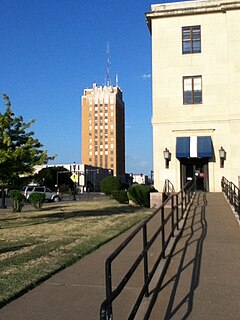
The Enid Downtown Historic District is a 296-acre (1.20 km2), seven-block district located in Enid, Oklahoma and listed on the National Register of Historic Places since 2007. The district includes the original downtown plat from 1893, part of the Jonesville addition plat from 1898, and part of the Weatherly addition plat from 1902.
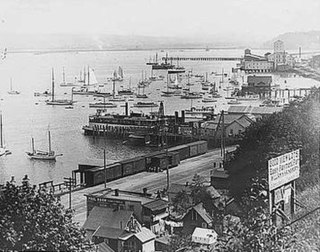
The West Seattle Land and Improvement Company was a real estate development concern that conducted business in West Seattle starting in 1888. Through a subsidiary, the Oregon and Washington Ferry and Navigation Company, the company also owned and operated two ferries that operated between the company's developments in West Seattle and Seattle itself, which was then a separate city which was difficult to reach over land routes of the time.
Ottawa Electric Railway Company was a streetcar public transit system in the city of Ottawa, Canada, part of the electric railway streetcars that operated between 1891 and 1959. Ottawa once had tracks through downtown on Rideau Street, Sparks Street and others, and extended outside of the downtown core to provide services that helped form communities such as Westboro, Old Ottawa South and The Glebe. Prior to this, starting in 1866, public transportation was provided by Ottawa City Passenger Railway Company, a horse-drawn tram service. The O.E.R. was taken over by the Ottawa Transportation Commission in 1948, which was itself succeeded by OC Transpo in 1973.

The Manhattan Bridge Three Cent Line was a streetcar company that operated cars over the Manhattan Bridge between the boroughs of Brooklyn and Manhattan in New York City. As the name implied, the fare was only 3 cents per ride.

The New York City Board of Transportation or the Board of Transportation of the City of New York was a city transit commission and operator in New York City, consisting of three members appointed by the mayor. It was created in 1924 to control city-owned and operated public transportation service within the New York City Transit System. The agency oversaw the construction and operation of the municipal Independent Subway System (IND), which was constructed shortly after the Board was chartered. The BOT later presided over the major transfers of public transit from private control to municipal control that took place in the 1940s, including the unification of the New York City Subway in 1940. In 1953, the Board was dissolved and replaced by the state-operated New York City Transit Authority, now part of the Metropolitan Transportation Authority (MTA).

